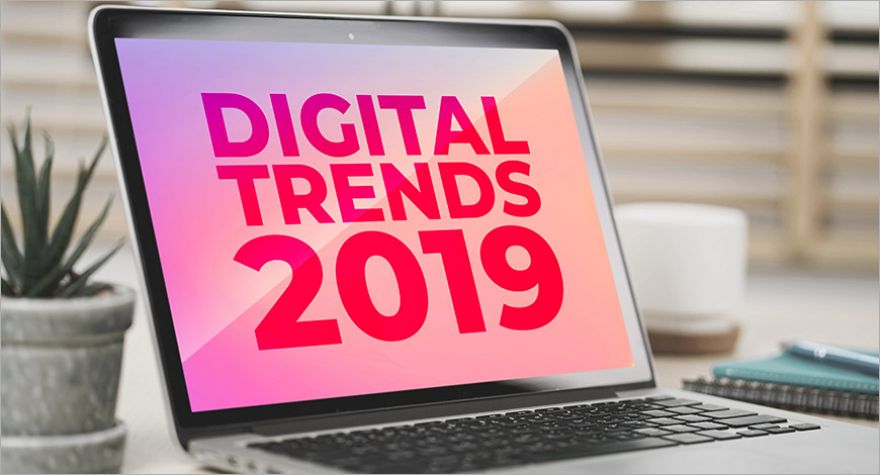
Digital trends in 2019
Video Marketing:
These numbers show the importance of incorporating video into your digital marketing strategy in 2019:
- 70% of consumers say that they have shared a brand’s video.
- 72% of businesses say the video has improved their conversion rate.
- 52% of consumers say that watching product videos makes them more confident in online purchase decisions.
- 65% of executives visit the marketer’s website and 39% call a vendor after viewing a video.
And don’t think of YouTube. To observer higher appointment with your video marketing, you can build a video post or start a live broadcast on Facebook, Instagram or LinkedIn.
Live video is gaining acceptance, with a big number of businesses using it for interviews, product demos and “behind the scenes” glimpses of events, life in the office, how products are made, etc.
With ever-decreasing costs of coating equipment and the high-quality smartphone cameras, businesses and marketers are heading for personalized video messages rather than phone calls or emails, which is called the 1:1 video approach.
YouTube and other videos are displayed in the SERPs, so video SEO is becoming much more important – like using text overlays and closed captions, besides your description, name and file names. Check out this guide to learn more about YouTube SEO.
And 360-degree video content, which allows for a more interactive experience, is on the rise – look for the circular symbol in the top left corner to start sliding the moving image left or right as it’s playing.
Voice Interaction Is Going Up:
Thanks to Siri, Google, Alexa, and a host of other “smart” devices, said interaction with devices is continuing to get up. The real takeaway is that talking is a preferred way of interacting. And now the machines are finally catching up to the way people want to search, shop, and discover new things.
But, this presents some interesting challenges. Conducting a voice search, for example, is very different from typing an inquiry, particularly in the results. When a person performs a text-based search, the screen displays one page at a time the results. But when someone asks a device to conduct a search and the device replies, it may only give a few choices at most, and, they supply one choice.
That means that preparing for voice searches is going to need a different advance, but it's one area of digital marketing that can't be ignored because people are relying on it now more than ever. For example, writing meta-descriptions of websites might need to be optimized for speech so that it "reads better" out loud, when being spoken, rather than the drier style used for a text-based search approach.
GDPR Forces Brand Hands:
As of August 2018, about 1/3 of companies were still not compliant with Europe’s General Data Protection Regulation (GDPR), which aims to provide large layers of data protection for users. In fact, now, about 1,000 U.S. news sites still aren’t available in Europe, commonly because they don’t care enough about data security to make the GDPR a priority. What does this mean 2019 digital change trends? It means informed customers will start to see which companies care about protecting their data, and which companies don’t. that GDPR is the start of a more global trend that will hold companies accountable for how they treat privacy and personal data. While brands do not want to have to comply, this movement will attend to as a warning to companies to figure out better ways to build relationships with their audience as opposed to the often clear misuse and pervert of personal data in the name of marketing and selling.
Consumption-Based IT Services for the Win (FTW):
This year, we did our homework, and asked the CIOs and IT executives about their IT budgets and trends in their consumption of cloud and , they are interested in creating efficiency, having more flexibility with their workloads (note trend 3) and having the ability to scale up and down based on the business requirements. This means, much like we saw Salesforce become a heavyweight for CRM as a Service, that the idea of anything and everything as a service is covered. With the as-a-Service industry growing, companies are becoming more sophisticated in choosing “a la carte” IT services to fit their needs. This ITaaS allows for scalability, the latest technology (without the latest tech price tag), shorter procurement cycles, and increased agility. It only makes sense that companies are leaning this way and they will be more and more in 2019.
It’s about time and while I’m putting this as my closing prediction, it is also the one that has me the most nervous. Countless studies have shown an overpowering desire from employees to see digital transformation start at the very top of the company, but, trends are still showing that the task is being too often delegated to IT, Marketing or HR departments. So even though we’ve seen a range of C-suite leaders charged with taking the reins of digital transformation, that the CEO will (must) finally step up in 2019, realizing digital transformation isn’t going anywhere. They’ll be making it more of a priority to hire for digital transformation, recognizing the critical nature of structure cultures that can change, and the value of reskilling employees and hiring for agility—learning to trust data more than ever before. That’s good news for all companies in 2019.
Connected Clouds (Public, Private, Hybrid):
We can file this as “the continued evolution and growing pains of cloud adoption.” What’s happening is that companies are realizing that going all public cloud, private cloud, or data center isn’t the best option. Sometimes, they need a mix of all or both. Thus, connected clouds are continuing to develop to meet companies’ changing needs—whether they want to cloud-source storage, networking, security, or app deployment. Larger public cloud providers like Amazon and Alibaba are answering the call, offering private cloud (or in Google’s case, container-based) options. We are also seeing Microsoft via Azure, HPE with their 2017 obtaining of Cloud Technology Partners and their consumable IT services as well as VMware with their recent acquisition of CloudHealth Technologies all show increased commitment to connecting clouds. The term, Multicolored will be the new buzzword for the cloud conversation and what this movement means more than anything else is that no matter which workloads are being run in which cloud, the experience for IT and those that are utilizing the applications need to be seamless, secure and streamlined. For most businesses this means a mix of workloads running in public, private and hybrid environments and this will be a great topic in 2019.
Blockchain Finally Understood and Flops (kind of):
Forget everything magical I ever said about blockchain. Kidding—kind of, but bear with me here. As we continue to explore this technological miracle worker, we’ve come to make real that blockchain a mess. It’s too complicated for lay people to use right now, and there’s no criterion way to use it because we all want to use it differently. The only way to get mass blockchain adoption is to create a plug-and-play version that all us can use and understand. I’m watching as leading technology firms like IBM continue to make massive commitments to the potential of Blockchain for applications beyond cryptocurrency. The financial industry is also looking at this as well as a mass of applications in the transportation of goods and services. But, to this point, it seems more of a marketing ploy than a bonafide technology offering. My guess is a lot of smart developers will continue to work on realizing the potential of blockchain in 2019, but I’m of the mindset that it will be 2-3 more years before we start to see the traction that has been promised.
Article source: Forbs.com



